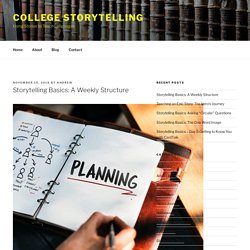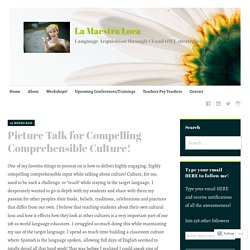

Irina Werning. Papiers back. Fiche back. JoosTricot - Walking to work late on Monday like Via... Facebook. Zillow. Calendar Days dias especiales - Google Slides. Jobtome - Ma semaine. Local Charlotte Church Released A Christmas Video That's Going Viral With Ove... The Deskless Classroom: A CI Teacher takes on IPAs (Integrated Performance As... Note: I invited my colleague and collaborator to write this post.

I was very, very interested in her experience teaching in a very legacy (but not grammar/memorization) way. She is a very highly trained and experienced TPRS/CI teacher who regularly presents at local and national conferences. I am humbled by her openness to try something that she doesn't think is going to help her students acquire language (albeit in the interest of keeping her job), and I deeply appreciate the time she spent both in writing this but also in reflecting on the experience in her classroom. To me, she displays two of the qualities I most value in a teacher: the willingness to experiment, and the habit of reflecting on her work.
Also, IPAs seem to be a hot new-ish trend. Hello! What is an IPA anyway? In an IPA, teachers create units around a theme. The How and Why of Using Gestures. 30 Hours & First Novella. With students meeting 1x/week—this year only—we just had the 30th class of the year.

I compared this to our calendar for next year, which is as if it’s October 9th meeting every day of the week. Now, with constant reminders of routines (since at least one week passes from class to class), and typical testing/school interruptions, and Northeast snow, those 30 class hours could amount to fewer total hours of input (25, 20, 15?!). Total input hours is tough to calculate, though, so we’ll just stick with 30 for the purpose of this post!
What does that mean for reading? Cue the first novella… Rūfus lutulentus is written with 20 words, and meaning is established for 5 more within the text. While answers to the former questions will soon be revealed, I can at least look into the last one before we begin. Novella Reading Process It’s interesting that without intentionally targeting the vocabulary for this novella, the high-frequency words naturally occurred throughout the year. Day 1. How should I use novels in class? As a teacher that has committed to teaching with comprehensible input based strategies like TPRS®, PQA, MovieTalk and Embedded Reading (to name just a few), you are probably aware of the incredible impact that reading has on language acquisition.

For this reason, you have likely also determined that you would like to use novels in your courses…but how? There is no wrong way for your students to read a target language novel that is comprehensible to them. If the text is interesting to your students and they understand it, their language skills will improve. The three kinds of reading that I will talk about in this post are Kindergarten Day (essentially, reading aloud to your students–maybe as they sit on pillows on the floor!) , FVR (Free Voluntary Reading, most likely in the form of Sustained Silent Reading), and teaching novels as units. I went on a shopping spree last week and purchased a slew of novels that I didn’t yet own and/or haven’t yet read.
Teaching novels as a unit Funding. Presentations. Designing the Classroom with the Brain in Mind: Brain-based Language Instruction IN-Nell Indianapolis, IN February 23, 2019 Lowering the Affective Filter: Theory to Practice IFLTA Indianapolis, IN November 3, 2018 Addressing Attrition: Compelling Input's Power to Empower Lifelong Learners CI Midwest Comprehensible Midwest Milwaukee, WI October 6, 2018 Teaching a Whole-Class Novel USI Dual Credit Spanish Classes Summer 2018 Addressing Attrition Central States Conference on the Teaching of Foreign Languages With Leslie Phillips, Park Tudor, Indianapolis, IN and Sheila Jordan, Round Rock High School, Round Rock, TX Milwaukee, WI March 2018.

Storytelling Basics: A Weekly Structure – College Storytelling. Using storytelling to teach language dramatically reshaped the the structure of my courses.

A progressively complex series of stories now anchor my lesson plans, instead of being shackled to the “communicative” activities in the textbook and its grammar-driven agenda. In addition, storytelling freed me from hours of lesson planning, since the stories we tell contain all the elements of the language I need students to learn. The mere act of telling and retelling a story (and later reading a story) affords learners the comprehensible input necessary for acquisition to take place. Free Stuff - Bryce Hedstrom - TPRS Materials & Training. TESTIMONIALS Here is what teachers are saying about Bryce’s presentations, keynote addresses and materials.

REJOINDERS List Lists of expressions to give students the tools too talk back in the Target Language. Seven Levels of Questioning to Build Student Confidence in Speaking Use simple questions to build student confidence using the language. How to teach such that they understand. If we want language to come OUT of our students’ mouths, we must get language IN to their heads. They need INput so that they can produce OUTput. » Input is reading and listening » Output is speaking and writing This is common sense.
A learner cannot utter an expression in a new language if they have never heard it or seen it. Yet not all input is created equal, and this is where we find some space for professional debate. Classroom-Job-Descriptions. TED - 4 Reasons to Learn a Second Language. A Natural Approach to the Year. Telling a Story to First Year Spanish Students - Adriana Ramirez. Begin your journey towards acquisition with a single question: “How are you f... At my TPRS training last summer, Lynette Saint George always started her lessons by asking students how they felt, she would circulate an iPad with a slide full of faces expressing different emotions.

At the time, I thought it was a very neat way of starting class. Comprehension-Based Classroom - Resource document. Principles_and_practice. A Frequency Dictionary of Spanish: Core Vocabulary for Learners (Routledge Frequency Dictionaries) (English and Spanish Edition) (8601416956152): Mark Davies: Books. The Learning Curve by Carrie Toth - Fluency Matters. TCI Activity Ideas. Input-Based Strategies & Activities. **Updated 3.5.19 with Guessing Game****Check out the companion post on Getting Texts!

** When choosing the class agenda beyond each particular day’s routine, it dawned on me that I couldn’t remember all my favorite activities. Thus, here are the input-based strategies & activities I’ve collected over the years, all in one place. Although this began as only reading activities, I decided that it didn’t matter as much whether students were reading or listening. Why?
**N.B. No Instructions Free Voluntary Reading (FVR) (Krashen-coined term? No Prep– Usually just projected text, sometimes less Guessing Game (shared by Kaitlin Leppert, from Luke Worthington)Determine categories (e.g. cibus, animālia, urbēs, colōrēs, etc.). Print Me! Lucky Reading Game (Senora Chase)+ Whiteboards & Playing Cards– Project this for scoringStudents Read & Translate in groups for X minutes.
Low Prep. Picture Talk for Compelling Comprehensible Culture! – La Maestra Loca. One of my favorite things to present on is how to deliver highly engaging, highly compelling comprehensible input while talking about culture!

Culture, for me, used to be such a challenge to “teach” while staying in the target language. I desperately wanted to go in depth with my students and share with them my passion for other peoples their foods, beliefs, traditions, celebrations and practices that differ from our own.